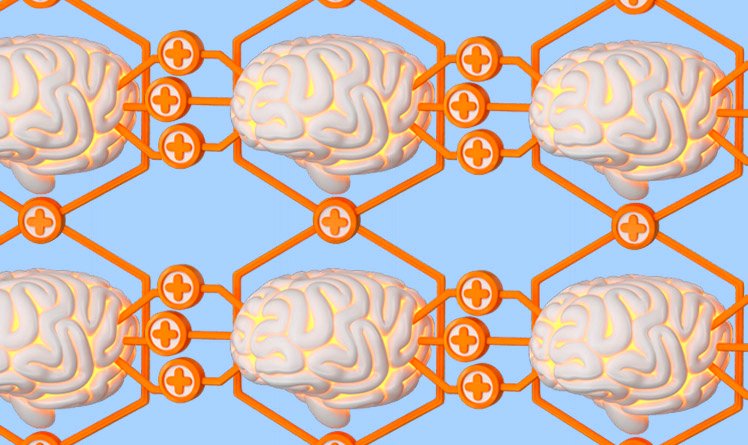Brainet: from the individual brain to the collective mind

|
Getting your Trinity Audio player ready...
|
Have you ever felt like someone “read your mind”? Or noticed that, when talking to someone close to you, you seemed to think and react in almost the same way?
Perhaps this is no coincidence.
Brazilian neuroscientist Miguel Nicolelis believes that human brains are capable of connecting with each other, creating true collective neural networks. He calls this Brainet, a concept that goes far beyond technology: it's a vision of the social and cognitive potential of the human mind.
But there's a fascinating detail: for Nicolelis, Brainet is not just a laboratory invention.
“"Brainet emerges from social groups that have the ability to exchange informational viruses, transmitted through efficient methods such as language."”
In other words, language is the first invisible thread that connects our minds. And the more conscious we are of what we transmit, the healthier and more powerful the collective network we all participate in becomes.
What is Brainet and why is this concept revolutionizing neuroscience?
THE Brainet It is a network of interconnected brains capable of exchanging neural information in real time. The term was coined by Miguel Nicolelis to describe experiments in which multiple brains work in direct cooperation, as if forming a shared mind.
In his early studies, Nicolelis connected the brains of rats and, later, monkeys, using implants that captured and transmitted electrical signals. These brains began to act in synchrony, learning and solving tasks together—something unprecedented in the history of neuroscience.
“"Brainet is a network of electronically interconnected brains that share neural information, enabling cooperation and collective learning."”
Over time, Nicolelis realized that this network doesn't need to be limited to technology. We humans are already part of a biological and symbolic Brainet: a system that feeds on language, emotion, and... empathy.
The birth of Brainet
The experiment that united minds.
Nicolelis discovered that by connecting two or more brains, it was possible for them to cooperate to achieve a common goal. Thus, in one of the most famous experiments, three monkeys, located in different places, collectively controlled a robotic arm. None of them could perform the task alone: only the sum of their neural activities produced the correct movement.
It was as if a new mind emerged, in a shared consciousness.
From neural communication to human potential.
If monkey brains can learn to work together, imagine what connected human brains could achieve. Thus, Nicolelis argues that Brainet could one day allow direct collaboration between minds, expanding our capacity for learning, empathy, and even collective creativity.
This discovery changes the central question of neuroscience:
“"Is consciousness an individual phenomenon... or a collective one?"”
From the individual brain to the collective mind.
The brain as a biological and social network
Each human brain is, in itself, a network composed of billions of interconnected neurons, forming pathways that constantly change through the neuroplasticity.
Now, imagine billions of human brains, each a living network, interacting with one another through language, emotion, and behavior.
Above all, Brainet merely mirrors technologically what nature has been doing for millennia: transforming individual brains into interdependent systems of consciousness.
“We are a hive of brains,” said Nicolelis. And neuroscience is beginning to confirm this metaphor.
Neural synchronicity and the power of empathy
Research from universities like Princeton and Harvard has shown that, during an empathetic conversation, people's brains synchronize. In this way, brain waves align, cortical areas mirror each other as if, for a moment, two minds become one.
This discovery is directly connected to the concept of mirror neurons, responsible for our ability to understand and reproduce the emotions of others. Therefore, Brainet simply amplifies, with technology, what empathy does biologically every day.
The brain as a mirror of the collective.
What we call "individuality" is, in fact, a partial illusion. Every thought we have is shaped by culture, language, and the interactions we experience. Thus, our mind is a product of the collective, and Brainet merely makes visible what has always existed invisibly: the mental interconnection between human beings.
Brainet and the collective unconscious
From science to symbology: Jung and the shared mind
Long before modern neuroscience, Carl Gustav Jung spoke of the collective unconscious, a shared psychic field that stores symbols, archetypes, and universal patterns of behavior. According to Jung, we are connected by an invisible network of meanings.
When Nicolelis shows that brains can communicate and cooperate directly, he offers a scientific image of this Jungian principle: the collective psyche translated into electrical impulses.
Morphic fields, resonance, and collective learning.
This is where the thinking of Rupert Sheldrake, a British biologist and thinker, comes in.
Sheldrake proposed the concept of morphic fields, information structures that connect similar beings and allow collective learning through resonance.
In his theory, when a new behavior is learned by a group, it becomes easier for other individuals of the same species to learn it, even without direct contact.
This idea, called morphic resonance, suggests that memory is collective, not just individual.
In this sense, Brainet is a modern confirmation of this hypothesis. It demonstrates, through technology, what Sheldrake intuited philosophically:
“"The mind is not confined to the brain, but extends beyond it, interacting with fields of information that connect us all."”
Nicolelis and Sheldrake start from different paths. The first, empirical; the second, theoretical. However, both converge on one point: the mind is a shared field.
Consciousness as an integrated system
If each brain is a biological antenna, then collective consciousness would be the common frequency that we all pick up. Thus, Brainet is not just a technology—it is a living metaphor for the mental and emotional coherence that occurs in human groups, families, companies, or spiritual communities.
Spirituality and science, at this point, meet: both speak of interconnectedness.
NLP, Mindfulness Positive Psychology in the Age of Connected Minds
Neural rapport: the basis of deep communication
In Neuro-Linguistic Programming (NLP), the rapport It is the ability to connect with another person so deeply that communication flows naturally. In this way, when there is true rapport, body, voice, and even breathing synchronize.
At Brainet, this concept takes on a new dimension: neural rapport. In other words, instead of just gestures and words, there is a literal brain synchronization.
Thus, what NLP calls "mirroring" finds scientific support in mirror neurons, which allow us to feel what the other person feels.
“"When we connect with someone, our brains dance to the same rhythm."”
As the Mindfulness It enhances brain and emotional coherence.
Practices of mindfulness, like meditation and conscious breathing, They increase the coherence between brain waves and reduce the activity of the amygdala, the fear center. When groups meditate together, for example, their brain waves become synchronized.
In other words, activities such as mindfulness They can create a natural and emotional Brainet, uniting minds through a state of presence. Being fully present is, in itself, an act of inner connection.
Positive psychology and collective harmony
Positive Psychology, as developed by Martin Seligman, teaches that emotions such as gratitude, empathy, and purpose strengthen our social connections. These emotions, above all, are reflected biologically: they increase the production of... oxytocin and serotonin, neurotransmitters that facilitate cooperation and well-being.
Thus, the emotional Brainet that already connects us daily is fueled by our positive mental and emotional states. The more love, the greater the harmony.
Towards the era of expanded consciousness.
From Brainet to the global brain
When minds unite with purpose, they create a field of collective thought: something Sheldrake would call... global morphic field. The digital networks we use today (internet, social media, artificial intelligence) are merely rudimentary versions of this expanded consciousness that is beginning to manifest itself biologically.
We are, primarily, moving towards what some call "biological singularity," the moment when technology and mind merge into a single web of information and emotion.
Ethical and emotional challenges
Every new form of power brings responsibility. Thus, a Brainet raises ethical questions: who controls access to a collective mind? How can the privacy of thoughts be guaranteed?
On the other hand, there is also the emotional challenge: being connected requires emotional maturity, self-awareness, and empathy. Without these, the mental network can become noise, or manipulation.
But the future doesn't belong to thinking machines. On the contrary, it belongs to human minds that connect consciously. Brainet shows that collaborating is more natural than competing.
Ultimately, evolution has never been about the survival of the fittest, but about the survival of the most connected.
Practical exercise: training neural empathy
Exercise in Conscious Tuning
- Find someone close to you (this could be a friend, partner, or colleague).
- Sit facing her, in silence, and observe her breathing.
- Gradually, try to synchronize your breathing with hers.
- After a few minutes, maintain light, effortless eye contact.
- Notice what changes in your bodily sensations: perhaps warmth, calmness, or a sense of presence.
This simple exercise creates neural and emotional coherence, a microcosm of the human Brainet.
This is how we begin to practice collective thinking in real life. No wires, no electrodes, just presence and empathy.
Final reflection: the power of a mind that recognizes itself in another.
In short, Brainet is not just a scientific revolution, it's a powerful metaphor for who we are.
Therefore, we must understand that we are not isolated individuals trying to connect. On the contrary, we are a single consciousness experiencing multiple points of view.
The true evolutionary leap lies not in connecting brains with wires, but in recognizing the unity that has always existed between them. Thus, when we understand this, we stop competing and begin to co-create.
And perhaps that is the true purpose of Brainet: to remind us that humanity is one mind, learning to recognize itself.
Questions and answers about Brainet
1. What is Brainet?
It is the name given to the network of electronically interconnected brains capable of sharing neural information in real time, created by Miguel Nicolelis.
2. What is Brainet's objective?
To study how different brains can cooperate and learn together, paving the way for advances in neurorehabilitation, collective intelligence, and mind-machine interfaces.
3. How does Brainet relate to the collective unconscious?
Brainet is a scientific analogy of the Jungian concept of the collective unconscious, showing how minds can share information and consciousness.
4. What does Rupert Sheldrake have to do with this?
Sheldrake proposed morphic fields: fields of information that connect similar beings. The Brainet is an empirical expression of this interconnection.
5. Is it possible to create a human Brainet without technology?
Yes. Through empathy, mindfulness, With rapport and positive emotions, our brains already synchronize naturally, forming an invisible emotional Brainet.
Image: Freepik

Marcel Castilho is an expert in neuromarketing, neuroscience, mindfulness and positive psychology. In addition to being an advertiser, he also has a Master's degree in NLP – Neurolinguistic Programming. As the owner and founder of the communications agency VeroCom and also of the digital agency Vero Contents, he has been studying human behavior for over 30 years.

